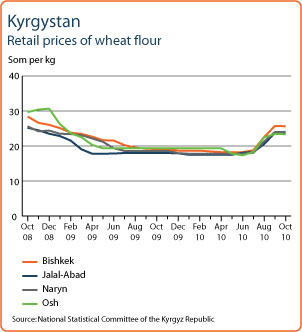Kyrgyzstan: Kyrgyzstan Agriculture Profile 2012
2012/03/14
Kyrgyzstan Agriculture Profile 2012
Crop production in 2011 similar to last year
Since 75 % of the country’s annual cereal output is under irrigation, high temperature combined with below average precipitation during spring and summer 2011 did not significantly impact crop conditions though led to low soil moisture in some parts of the country. In order to ease drought conditions in downstream areas during July and August, the water authorities increased outflows from the Toktogul reservoir. Water volumes at the reservoir, which has a multi-year storage capacity, continued to be above (35–45 %), the seasonal averages for the May-June period.
Harvesting of the 2011 cereals is about to be completed, with those of wheat and barley almost finished, except in northern parts of the country, and that of maize still ongoing. Preliminary official estimates wheat and barley production in 2011 is put at 830 000 and 250 000 tonnes respectively, around last year’s level and slightly below the previous-year average. The maize production is estimated to increase by 7 % compared with last year’s level to 447 000 tonnes. Land is under preparation for planting of the 2011/12 winter cereal cropping season.
The country heavily depends on wheat imports for food consumption
The country needs to import a significant volume of wheat to satisfy food consumption. Cereal import requirements are estimated at around 46 % of food consumption in 2011/12 marketing time(July/June) or 830 000 tonnes, a level similar to that recorded in the 2010/11 marketing year. To stabilize the food supply situation, the country authorities have build-up a high level of stocks since 2009, following a bumper harvest recorded.
Food prices of staple products remain high
Wheat flour prices which had slightly decreased in July continued to drop in August following the arrival of the 2011 wheat harvest. The resumption of fuel deliveries from the Russian Federation in late July contributed to lower transport costs and food prices. However, despite the recent declines, wheat flour prices in most markets remained 30 to 40 % above their levels in August 2010.
Reference Date: 25-May-2011
|
FOOD SECURITY SNAPSHOT
|
2011 winter cereal crop production could decline following lower plantings
The area planted to 2011 winter cereal crops, mainly wheat, is estimated to have decreased by 4 %. Precipitation and soil moisture at sowing time, October-November of 2010, were not favourable for planting and subsequently rains have been erratic in the major southern growing areas. Production is estimate to decline comparing with the same season last year. Winter wheat normally accounts for some 60 % of annual production. Spring sowing is close to completion. Adequate precipitation was received in April and May 2011 normalizing soil moisture conditions and planting and development of crops. In general, total cereal production is estimate at some 1.5 million tonnes or about the average level of last year. A significant 30 % increase of sowing of oilseeds and cotton is reported.
Cereal imports remain high in 2010/11 (July/June)
Cereal import requirements, mostly wheat, are estimated at around 437 000 tonnes in the 2010/11 marketing time(July/June), which is about 20 % higher than in the previous year because of the decline of 2010 production and stock replenishment. Imports of wheat and wheat flour, mostly from Kazakhstan, represent 33 % of domestic wheat consumption.
Increasing food prices remain a concern for food security of vulnerable populations
Prices of bread and wheat flour, which have been steadily increasing since June 2010 rose further in April 2011. National average prices of wheat flour and bread in April 2011 were 80 % and 33 %, respectively higher than in the same month of 2010. The major factors driving up food prices are a decline in 2010 production, higher wheat import prices, higher prices of fuel and other agricultural inputs. The higher food prices negatively affect vulnerable households, who spend around 65 % of their budget on food.



- Kyrgyzstan News
-
- AFGHANISTAN: UNWTO: International tourism – strongest half-year results since 2010
- KYRGYZSTAN: Better Uzbek-Kyrgyz relations are due to Mirziyoyev's policy
- KYRGYZSTAN: Kyrgyz parliament approves new PM
- CHINA: China-Kazakhstan free trade zone sees 1 mln visitors in Q1
- CHINA: China, Kyrgyzstan to boost trade, economic cooperation
- CHINA: China ready to improve security cooperation among SCO members
- Trending Articles
-
- SOUTH AFRICA: KPMG's South Africa bosses purged over Gupta scandal
- CHINA: Life after Rosneft deal: CEFC ambitions face debt, regulatory hurdles
- TANZANIA: Critic of Tanzania's Magufuli moved to Kenya for treatment of gunshot wounds
- CHINA: BRICS countries considering own cryptocurrency as settlement mechanism
- ITALY: Italy Current Account Surplus Grows In June
- CHINA: Zhongwang Acquires German Alumnium Extrusion Firm ALUnna






.gif?1356023993)



